What is Discoloration Assessment?
Procedure of Discoloration Assessment?
1. Set to the discoloration assessment display mode of the color meter
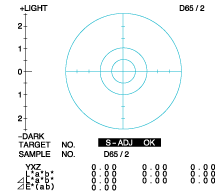 |
Figure. 1 The discoloration assessment chart consists of a flat chart on the right, measuring the hue difference and the chroma difference, and another chart on the left, measuring the brightness difference. Usually, the left-hand chart will be standing up at right angles from the origin of the flat chart on the right, but it has been positioned on the same plane here for greater ease of display. |
2. Measuring the target color
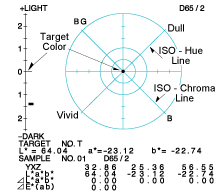 |
Figure. 2 At either end of the straight line we have the descriptions "Vivid" and "Dull" . This line is called the iso-hue line. There is another straight line that intersects the iso-hue line. This is called the iso-chroma line. At either end of this iso-chroma line, we have a display of symbols, In Figure. 2, these are "BG" and "B" . The hues are staggered in circular pattern or loop starting with red and going through orange, yellow, yellow-green, green, blue-green, blue, purple-blue, purple and purple-red and ends with red again. |
3. Measuring the sample color
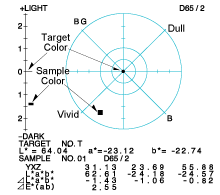 |
Figure. 3 When measuring the sample color, the position of the sample color is displayed on the discoloration assessment chart. |
4. Judge the direction of discoloration and its amount
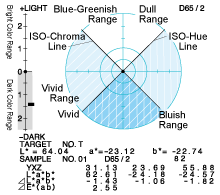 |
Figure. 4 The chart on the left of the discoloration assessment chart shows the brightness difference on the ΔL* axis. Taking the brightness position of the target color as 0, the indication "Light" indicates a range in which "color is bright" and the indication "Dark" refers to a range in which the "color is dark" ±0 indications shows that the brightness is the same as that of the target color. |
5. Discoloration assessment result
The sample color is shifted to, the hue is 1.1 (Bluish), the brightness is 1.5 (Dark) and the chroma is 4.0 (Vivid) from the target color. 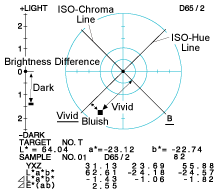 |
Figure. 5 With the iso-chroma line as the limit, the DULL side indicates the "dull range" (low saturation or chroma) with respect to the target color. The Vivid side indicates the "vivid range" (high saturation or chroma) with respect to the target color. If the sample is positioned on the same line, it means that it has the same saturation or chroma. With the iso-hue line from Vivid to Dull as the limit, the right-down side indicates the range in which the color is shifted to a hue on blue (B)- side with respect to the target color. Similarly, the left-up side shows a color shifted to a hue on the blue-green (BG)- side with respect to the target color. Values positioned on this line indecates that the color is the same as the hue of the target color. |
